Caring for the Earth: SITES® Criteria to Create Home Landscapes
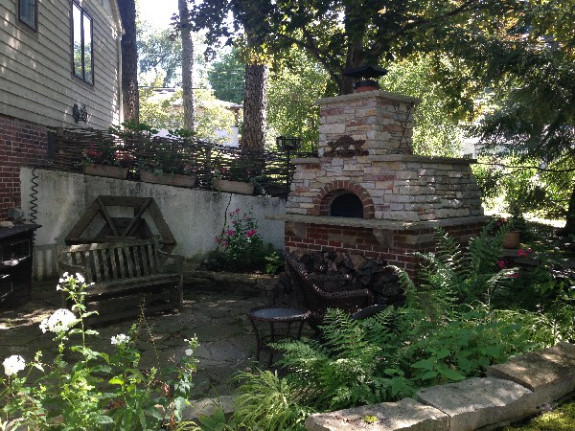
The model for development of home landscapes in our country is to rip out everything, destroy what was there before or even completely cover the earth for our own entertainment at a high price to the earth around our buildings. We arrange the land to suit our needs, often with disregard for what already exists and without asking what we can do to improve upon or offer to nature in our home landscapes.
The Sustainable SITES Initiative® or SITES® (a registered trademark of GBCI® is a process that offers an entire industry and our culture a new way to approach the development of the land around us. SITES® is based on the fundamental idea that any project can potentially regenerate, improve and protect the free ecosystem services that benefit us all. SITES® is the most comprehensive system for developing sustainable landscapes. Details at http://www.sustainablesites.org. Read on for some insights on how as homeowners we can be inspired by these concepts.
First, what are ecosystem services? Processes like cleaning the air we breath and filtering water through plant cycles of evapotranspiration, water uptake and infiltration into our soils; shade provided by trees; healthy soils to serve the plants in our yards and maybe even assist us in growing some of our food to eat. As one gardening friend of mine, Vickie Nowicki says, "If a person can see where their food is coming from, it assists in their own sense of security and well-being." This is yet another eco-system service. We take these things for granted and forget how vital they are to our lives. By stepping out of old thinking about the land around us, we can find ourselves looking before we leap and reaping the rewards of being invited into and preserving aliveness in the world around our homes.
Let’s run quickly through the basic 18 Pre-requisites (P for short) which are an excellent starting point for any home project. There are 7 categories that take you through your project from start to finish.
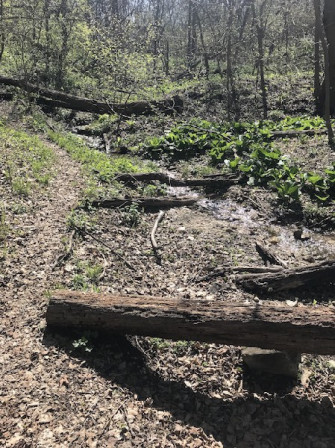
Whether the area where your home is built is a woodland ravine or a prairie,
a sandy city lot near a great lake or a savannah's edge, look to see how nature
used to live where you live now.
1. Site Context (think…where does your property sit in relationship to the big picture of your local ecology, farmland, flood plain and watershed)
- P1.1 Limit development on farmland (self explanatory)
- P1.2 Protect floodplain functions (in highly populated areas this is applicable to everyone who has water rushing off of their properties instead of slowing, spreading and infiltrating water where it lands, which is a function of floodplains)
- P1.3 Conserve aquatic systems (i.e. wetlands, seasonal streams, rivers and lakes that could be impacted by your property's chemical pesticides or fertilizers)
- P1.4 Conserve habitats for threatened and endangered species (almost every human inhabited area has local extinction of all forms of life; amphibians; insects vital to the life of birds we love; pollinators and butterflies that need specific plants to live and rear their young. Many species are going or have already gone locally extinct because of lack of habitat)
2. Pre-Design Assessment + Planning (ask questions, learn from others, decide what is important, make a plan and prioritize these things when creating your budget)
- P2.1 Use an integrative design process (Include your architect, neighbors, contractors and maintenance assistants when planning how to institute your ideas before you begin)
- P2.2 Conduct a pre-Design site assessment (how does water flow over the land before you even start, what soil do you have, can you reuse any hardscape, stone, brick or plants that are already there)
- P2.3 Designate and communicate areas to be protected during construction (establish vegetation and soil protection zones; recognize the value of existing trees and other plants on the property and protect as much soil as possible from heavy equipment compacting it; reserve precious topsoil for re-use)
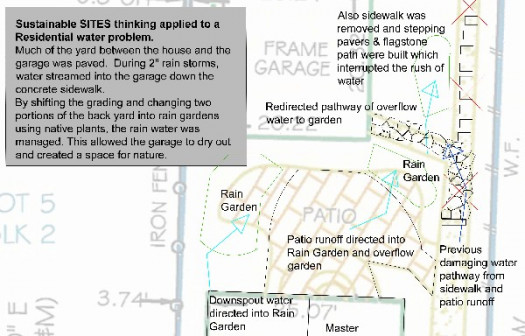

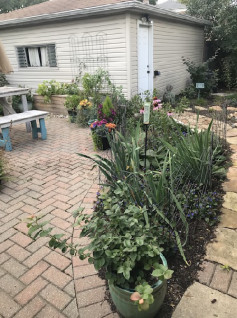
The 2 photos illustrate changing a suburban desert into a lush habitat that went from zero pollinator visits to 5 varieties of native bees, 8 butterfly species and several humming bird visits.
3. Site Design – Water (Evaluate if you have water coming onto your site from neighboring properties to understand how much water you will generate from your own house and hardscape footprints)
- P3.1 Manage precipitation on site (Plan how to regulate your water using, rain gardens, swales, rain barrels, cisterns, green roofs and rechargers to infiltrate as much water as possible on your property; create raised gardens to receive overflow into from neighboring properties that are higher than your own)
- P3.2 Reduce water use for landscape irrigation (Plant plants that have low watering requirements in dry areas and adaptive plants for seasonal “flooding”; Use temporary, drip irrigation for the initial establishment periods of your new plantings to reduce water waste and other water use reducing strategies)
- P4.1 Create and communicate a soil management plan (Soil testing will be especially helpful – Brookside Laboratories is a good source to test soils because they add micronutrients into their analysis and can test compost too; the correct tests will let you know if you need to add compost, what nutrients are available to your plants; testing infiltration rates of your soil you can do yourself, just check the internet to help understand what you need to do)
- P4.2 Control and manage invasive plants (Removing plants such as buckthorn, barberry, Callery pear, mustard garlic and other plants that are capable of overwhelming native habitats is a simple and vital contribution we can make)
- P4.3 Use appropriate plants (Look at the site conditions, intention of your design, and climate; be sure the plants you are choosing match the sun, soil and moisture requirements for the area of the garden where they will grow)
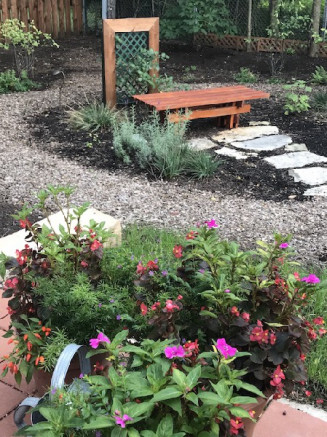 This client had an old plastic fence we repurposed into a trellis for a native honeysuckle vine. The flagstone was on the property prior to construction and the patio was set as a permeable hardscape that allow for water infiltration where it lands. Additionally the pathway around the property is made of wood chips, allowing for easy movement through the gardens and utilizing a resource that is local and will break down to create better soils after time.
This client had an old plastic fence we repurposed into a trellis for a native honeysuckle vine. The flagstone was on the property prior to construction and the patio was set as a permeable hardscape that allow for water infiltration where it lands. Additionally the pathway around the property is made of wood chips, allowing for easy movement through the gardens and utilizing a resource that is local and will break down to create better soils after time.5. Site Design – Materials (Simply put, do less harm. If you want to do more than the basics, choose materials for your site that are produced regionally - within 300 miles or closer if possible to reduce the carbon footprint of your project)
- P5.1 Eliminate the use of wood from threatened tree species (I encourage clients to use wood from black locust which is actually harvested from the Urban forests of our area by one of our own local companies. Here's a source that would score you at least 3 points extra if you purchased wood from them because they would easily be within 50 miles of any Chicagoland project! Horigan Urban Forest Products)
6. Site Design – Human Health + Well-Being Here there are no prerequisites and at the same time it is the soul of why this initiative is so impactful: Enhancing physical, mental, and social well-being as a result of interaction with nature. Ecosystem services are many. Listed here are the 12 summarized by the program:
- Global Climate regulation (Keep more carbon in the ground through roots of plants; balance carbon monoxide and oxygen exchange atmospherically; filter pollutants)
- Local climate regulation (local temperatures, precipitation, and humidity)
Air and water cleansing (Evapotranspiration cycle of trees and plants) - Water supply retention (think green roofs and rain gardens; watersheds to local rivers and lakes and aquifer renewal)
- Erosion and sediment control (plants hold soil on slopes and keeps erosion from removing precious topsoil)
- Hazard mitigation (i.e. reduce flooding, wildfire risks, drought damage, etc.)
- Pollination (Native plants provide homes for native pollinator species which can help with pollinating food crops as well)
- Habitat functions (a home, food, “neighbors” and cover for our wild flora & fauna)
- Waste decomposition and treatment (Intentionl composting and cyclying nutrients back to the soils; good to know that plants produce their own food like magicians when the soil is alive and balanced)
- Human health and well-being (eat fresh organic food you grow, smell the lavendar and wild hyssop)
- Food and renewable non-food products (imagine wild strawberries and willow fences woven from local willow and so much more)
- Cultural benefits (educational, aesthetic – i.e. hearing the wind through grasses and fragrance of Monarda – Wild Bergamot; feeling a close connectedness to the aliveness of the natural world – described by some as spiritual)
 This blue spruce was highly valued by the client and the construction fence protected its root system from compaction and when we built the hardscape we also protected the root zone by putting in a retaining wall to correct the grade change from the patio to the main gardens.
This blue spruce was highly valued by the client and the construction fence protected its root system from compaction and when we built the hardscape we also protected the root zone by putting in a retaining wall to correct the grade change from the patio to the main gardens.7. Construction (Here’s where paying attention really pays off. For some contractors, old habits die hard and making sure the companies you hire are on board is essential to success. The initial team meeting approach can be very productive, creating a sense of teamwork and collaboration can be vital. You want your contractors working in harmony with each other and not at odds with one another playing blame games!)
- P7.1 Communicate and verify sustainable construction practices (Set up off limits zones with fencing to protect existing trees root zones, thriving plants zones and healthy soils; stock pile valuable topsoil when possible)
- P7.2 Control and retain construction pollutants (Help your contractors to understand that the dumping of excess paint, concrete and other such construction debris into the soil will impact the opportunity for new plants that will be placed where construction once took place; on the other hand the breaking up of old concrete on site can often be recycled to create a base for new hardscape to be installed or pieces can even serve as a footwall or raised bed, these ideas are related to extra points that can be won in the certifying process)
- P 7.3 Restore soils disturbed during construction (Here you may have to encourage contractors not to be tempted to bury construction debris which can happen; sometimes you can even reuse some of the subsoils of the property if you amend them with organic compost; be careful to have clay soils that are rototilled aerated if a hard pan has been created through construction compaction and tilling)
8. Operations + Maintenance (Here’s where the rubber meets the road. Many naturalizing style landscapes are still gardens and proper care of your new garden can give you years of appreciation and discovery as the new habitat home you have created will bring new experiences every season)
- P8.1 Plan for sustainable site maintenance (Get to know the new plant friends you have invited into your garden; identify invaders, iNaturalist is an app you can use to ID plants that are not familiar.Weed well and use leaf mulch for areas with perennials. Do good establishment watering for the first 6 weeks for perennials with an eye on drought conditions the first year. For shrubs watering regularly all season for the first two years can be a great start for your new woodies. For trees, give supplemental watering for the first three years depending on the caliper of the tree initially planted and support them in times of drought. Use drip irrigation for the best water conservation. Low emitting machinery and equipment reducesair and sound pollution, use electrically run equipment when possible.)
- P8.2 Provide for storage and collection of recyclables (Reduce waste going to landfills and keep materials in the reuse cycle such as paper, glass, plastics and metals. Many cities today provide recycling bins for collection)
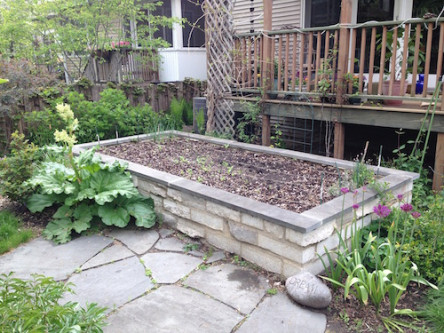 This raised vegetable bed was created from concrete that had been previously laid on the site and was "quarried" to create the look and feel of a stone bed by integrating a few actual stone elements and capping the material with a bluestone cap to class up the look.
This raised vegetable bed was created from concrete that had been previously laid on the site and was "quarried" to create the look and feel of a stone bed by integrating a few actual stone elements and capping the material with a bluestone cap to class up the look.This brings us to the close of some basic considerations using the SITES® Guidelines. Two more sections exist that contain no prerequisites. Section 9 is based in Education + Performance monitoring. Section 10 is for Innovation and creating new ideas that could be integrated into the SITES® system.
We can all share whatever we learn in our experiences with our home’s land whether it be growing food and sharing it with our neighbors, inviting more habitat space into our yards for the local insect population and the birds that enjoy them or being responsible for the water that comes off of our roofs and impervious surfaces. We can all this by observing and growing a relationship with the natural world around our homes. The very nature of this relationship can change from chores in the yard to times of connectedness and connection with the living landscape that is growing around our homes. And can help in the movement toward a regenerative and life sustaining world.




